
Demo
Ride Narrative Description
Hangars can become very crowded. Long wings overlap everywhere.
Watch where you are going!
|
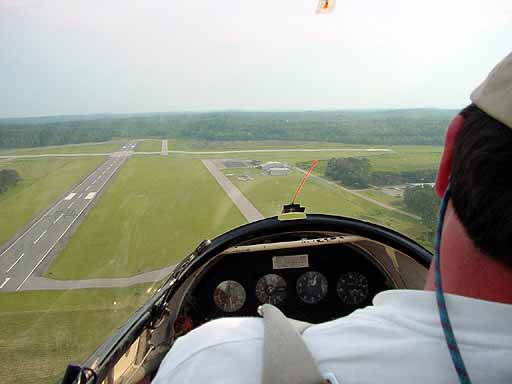
We
operate off runway 36 on most days. We take off on the hard surface
and sometimes land on the grass. Wally is landing on the grass. Roosevelt has a paved runway. Runway 18/36 is 5,001
feet long and 75 feet wide.
Gliders need only a few thousand feet to launch, and a few hundred
feet to land.
|
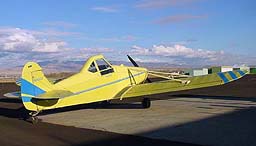
A good tow
plane has a powerful engine and a wing design that is optimized
for climb. It can fly slowly. It doesn't overheat when doing multiple
tows. It has great visibility and is fun to fly. After all, need
to keep our tow pilots happy. We operate an aircraft designed for
towing - a 235-hp Piper Pawnee.
|
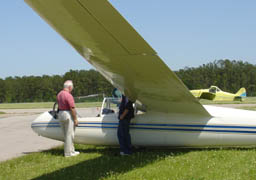
Let's talk before that first flight. Charlie is reviewing
the cockpit procedures with James, another of our 14 year old
students. Safety first, James gets an orientation on emergency procedures.
The tow plane is waiting in the background.
|
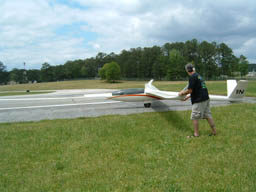
During initial
ground roll, the pilot uses the ailerons to keep the wings level,
and the rudder-pedals to keep the nose of the glider down the runway.
A little forward pressure on the stick, lifts the tail wheel. When
beginning to fly, coordinating the three axes of flight is a real
challenge. As your experience increases, the control movements become
automatic. You don't even think about it. As speed increases, the
landing gear may bounce. Before you know it, we lift off and everything
becomes quiet. You're flying...
|
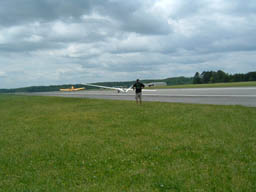
Once off
the ground, you ease the controls forward, to stay a few feet above
the runway. The glider wants to climb, but the tow plane is still
on the ground. As the tow plane increases speed, he lifts off too.
You ease back on the stick, and follow the tow plane in formation.
The tow plane turns toward the lift ahead. We bank to follow. We
ease up to 2,000 feet above the ground. It's time to be on our own.
Reach forward and pull the release. The tow line drops away toward
the tow plane.
|
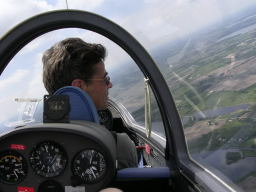
The tow pilot feels the release,
banks to the left, and descends back to the airport for another
tow. Off tow, we bank to the right. This provides separation between
us and the tow plane. Now we're on our own. It's time to start using
the energy Mother Nature has provided us, to start a climb. Don't
forget to look around! It's beautiful up here, smooth and
quiet. Remember, we are a glider and are always descending. We don't
have an engine to help us climb. We're looking for air that moves
up faster than our glider descends. Many times, we can out climb
powered aircraft. See those puffy clouds, over there. That could
be our refueling station.
|
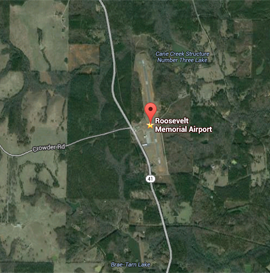 What
creates that rising air? Basically, it's uneven heating. Dark, dry
terrain heats up faster than lush, green, wet terrain. A bubble of
hot air begins to form. Perhaps it's over a parking lot, or a plowed
field. Eventually, that bubble of hot air releases and rises. We've
all watched bubbles rising in a boiling pot of water. It's very similar.
The air cools, as it rises. If there is moisture in the rising air,
it condenses and forms a cloud when the temperature cools to the dew
point. That cloud marks the rising air for us. No clouds? We look
for other markers. These could be soaring birds, or the extremely
sensitive instruments on our panel. Often it's just the seat of our
pants. We can feel when Mother Nature gives us a boost up! Look at
all that pavement at our airport. Think of the heat it can release.
While you're at it, remember where it is. It can be embarrassing to
get lost! What
creates that rising air? Basically, it's uneven heating. Dark, dry
terrain heats up faster than lush, green, wet terrain. A bubble of
hot air begins to form. Perhaps it's over a parking lot, or a plowed
field. Eventually, that bubble of hot air releases and rises. We've
all watched bubbles rising in a boiling pot of water. It's very similar.
The air cools, as it rises. If there is moisture in the rising air,
it condenses and forms a cloud when the temperature cools to the dew
point. That cloud marks the rising air for us. No clouds? We look
for other markers. These could be soaring birds, or the extremely
sensitive instruments on our panel. Often it's just the seat of our
pants. We can feel when Mother Nature gives us a boost up! Look at
all that pavement at our airport. Think of the heat it can release.
While you're at it, remember where it is. It can be embarrassing to
get lost! |
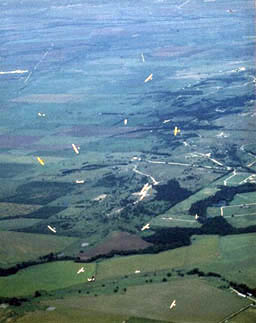
There's nothing
quite like circling in a thermal with another sailplane. I must
admit, this example is a little extreme and out of the ordinary!
On days when lift may be hard to find, seeing another glider climbing
in a thermal marks a good spot. We lower the nose, and fly over
to join him. Suddenly, a few more pilots join us. Now the contest
may be on. Who can out climb the others? Which glider has the best
climb performance?
|
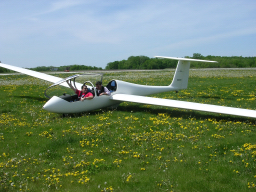
After landing,
life slows down. Gliders are handled carefully as they are fitted
with tail dollies and towed at walking-speed back to the hangar
or to their trailers. Bugs are wiped off the leading edges of the
wings, canopies are cleaned, batteries are plugged in for recharging.
The flight review begins for students; pilots download GPS flight
recorders to their laptops and replay their day's flight in 3-D
on specialized software. Logbooks are updated.
|
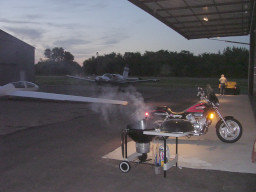
Drop by
to watch, go for a ride, or join the club.
Often, we'll have a cookout at the end of the day. You're welcome
to join us. It's a great time to talk about soaring, or just to
meet others from all walks of life. Maybe you'll make some life-long
friends.
If we've interested you, contact
us for more information.
Directions to SES.
|
|
